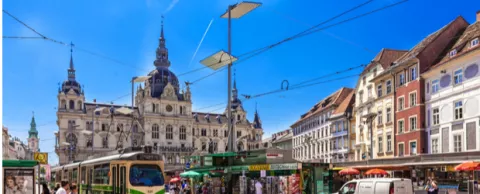
At the moment, Graz—the capital of the state of Styria and Austria’s second-largest city after Vienna—boasts the country’s only Smart City flagship project. Targeting the former industrial area near the centre of Graz, the smart urban development strategy will transform this local land reserve in Graz West into a residential area where sustainability is placed at the forefront. Part of the “Smart City Graz” strategy, this new development will revolve around solving the expanding city’s issue of limited building land (due to its topographical location in a basin) while also meeting Graz’s zero emission and carbon neutral goals by 2050. Below, we’ll look at three ways this UNESCO World Heritage site is preserving its past while preparing for a sustainable future.— Philippe Leonard
- Innovative infrastructure: As part of the renovation plans for the cultural venue Helmut-List-Halle, the city is constructing an energy plant that will supply the district with carbon-neutral energy. This is key, as the plant will act as the first local energy network. In addition, the Smart City’s cornerstone will be a 60-metre-high “Science Tower,” which will serve as a hub for research institutions and feature a public rooftop garden.
- New energy technologies: To become a “Zero-Emissions City,” Graz is looking at new forms of energy technologies that will be incorporated for the first time. One of the main technologies: Grätzel (dye-sensitized solar) cells, which replicate a plant’s photosynthesis process to turn light into an electrical current. By placing these cells in the glass walls and roof of the city’s new Science Tower, they’ll also offer acoustic insulation for the district thanks to their noise protection elements.
- Large-scale solar thermal energy: Graz aims to produce 100 percent of the urban region’s required energy from renewable energy sources. The city has already been successful in integrating industrial waste heat sources into the local urban district’s heating system. According to Graz City Development Project Coordinator Christian Nußmüller, the next step is to use renewable energy sources on a larger scale, but this has been a slow process due to “local natural and economic framework conditions.” But if the city installs 500,000 m2 of solar collectors, it can cover 20 percent of the local district heating system’s energy demand. The key now is getting both the public and private investors aware and on board to finance a project such as this one.
By looking at urban technologies for the use of renewable energy sources in the new Smart City district of Graz Mitte, the city is well on its way to becoming a “Zero-Emissions City” by 2050.



